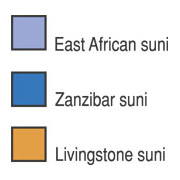 |
 |
Neotragus moschatus livingstonianus
Named after the missionary and explorer Dr. David Livingstone (1813-1884).
DESCRIPTION Shoulder height about 14-15 inches (35-38 cm). Weight about 10-15 pounds (4.5 to 6.8 kg).
The Livingstone suni is larger than the East African suni and has longer, thicker horns. The general color is a rich reddish brown, with the lighter colored hair tips on the upper parts giving a faintly speckled appearance. The back, neck and top of the head are darker.
DISTRIBUTION In South Africa, Livingstone suni are found in Zululand north of the Hluhluwe River and in northeastern Northern Province. Also in southeastern and northeastern Zimbabwe, most of Mozambique, and southern Malawi. For convenience in record keeping, we use the border between Mozambique and Tanzania to separate the Livingstone suni from the East African suni.
REMARKS The suni is a demanding game animal. The usual hunting method is by slow, silent stalking in thick cover, with frequent glassing. However, if in an area with smooth roads that allow a vehicle to travel quietly, it is often productive to cruise slowly during the early morning and again in late afternoon, peering carefully into the bush on either side. When a male suni is spotted, it is stalked in the thick cover, which calls for agility, the ability to move soundlessly, and sharp eyesight. One should wear as little clothing as possible, and soft, smooth sneakers. Suni are usually taken with a shotgun using small shot; however, if the range is short, this can damage the fragile skin, or even blow the horns off. A case can be made for using a very small-caliber rifle, or a larger one with solids. Any scope should be of low power.
TAXONOMIC NOTES Includes livingstonianus (southern Malawi and Mozambique north of the Zambezi) and zuluensis (South Africa, Mozambique south of the Zambezi, and Zimbabwe), with livingstonianus Kirk, 1865 having priority.
|





